International Toy Fair Nuremberg 2011
Internationale Spielwarenmesse Nürnberg 2011
| x |
|
|
|
|
|
|
|
|
|
|
|
|
|
|
|
|
|
|
|
|
|
|
|
|
|
|
|
|
|
|
|
|
|
|
|
|
|
|
|
|
|
|
|
|
|
|
|
|
|
|
|
|
|
|
|
|
|
|
| Eggertspiele |
|
|
|
|
|
|
|
|
|
|
|
|
|
|
|
|
|
|
|
|
|
|
|
|
|
|
| x |
|
|
|
|
|
|
|
|
|
|
|
|
|
|
|
|
|
|
|
|
|
|
|
|
|
|
|
|
|
|
|
|
|
|
|
|
|
|
|
|
|
|
|
|
|
|
|
|
|
|
|
|
|
|
|
|
|
|
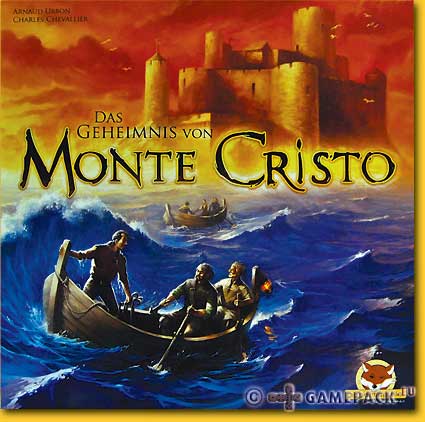 |
Collect treasures in the infamous Chateâu d'If where the innocent Count of Monte Cristo was held imprisoned, far away from his love. Rumour has it that he has hidden the treasure he found in the chateâu and we as players all want to search for it as it brings us, eh, points? Not just ordinary money, gold or bracelets? |
|
|
|
|
|
|
|
|
|
|
|
|
|
|
|
|
|
|
| x |
|
|
|
|
|
|
|
|
|
|
|
|
|
|
|
|
|
|
|
|
|
|
|
|
|
|
|
|
|
|
|
|
|
|
|
|
|
|
|
|
|
|
|
|
|
|
|
|
|
|
|
|
|
|
|
|
|
|
| Each player starts with two treasure hunters that already made it to the island, and has seven more he can bring into the game later on. A special socalled 'action slide' filled with small coloured balls determines which player is the active player in one of the four phases in a round, something we have seen before in 'Darjeeling' from AbacusSpiele. After having executed the action, the player takes his ball and puts it in the back of any of the three other rows, taking into account that he may never have more than three of his balls in a row. |
|
|
|
|
|
|
|
|
|
|
|
|
|
|
|
|
|
|
| x |
|
|
|
|
|
|
|
|
|
|
|
|
|
|
|
|
|
|
|
|
|
|
|
|
|
|
|
|
|
|
|
|
|
|
|
|
|
|
|
|
|
|
|
|
|
|
|
|
|
|
|
|
|
|
|
|
|
|
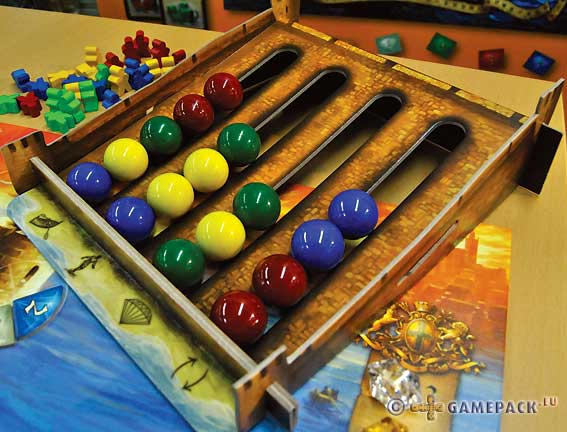 |
|
|
|
|
|
|
|
|
|
|
|
|
|
|
|
|
|
|
| x |
|
|
|
|
|
|
|
|
|
|
|
|
|
|
|
|
|
|
|
|
|
|
|
|
|
|
|
|
|
|
|
|
|
|
|
|
|
|
|
|
|
|
|
|
|
|
|
|
|
|
|
|
|
|
|
|
|
|
| The first action is drawing as many provision cards as there are players. These cards show an amount of treasure hunters as well as bags in a certain colour. The active player chooses one of the cards and deals the other players a card. All players take as many treasure hunters from the supply as indicated on their card. The cards are placed face up, so all players can see the bags on them. |
|
|
|
|
|
|
|
|
|
|
|
|
|
|
|
|
|
|
| x |
|
|
|
|
|
|
|
|
|
|
|
|
|
|
|
|
|
|
|
|
|
|
|
|
|
|
|
|
|
|
|
|
|
|
|
|
|
|
|
|
|
|
|
|
|
|
|
|
|
|
|
|
|
|
|
|
|
|
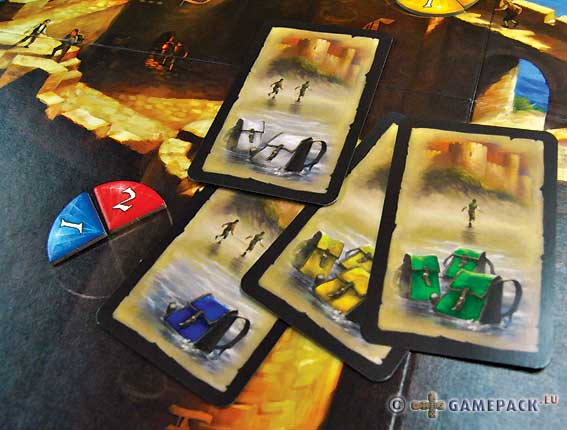 |
|
|
|
|
|
|
|
|
|
|
|
|
|
|
|
|
|
|
| x |
|
|
|
|
|
|
|
|
|
|
|
|
|
|
|
|
|
|
|
|
|
|
|
|
|
|
|
|
|
|
|
|
|
|
|
|
|
|
|
|
|
|
|
|
|
|
|
|
|
|
|
|
|
|
|
|
|
|
| In the second action the active player may place three treasure hunter on the board, any number in any prison or one in the bonus area at the top of the game board. After this the other players may place one treasure hunter. The bonus area immediately gives the advantage of the space the hunter was placed in: draw an additional provision card, acting as a bag of any colour; take three treasure hunters from the general supply; take two victory points; or place up to two additional treasure hunters in one or two prisons. |
|
|
|
|
|
|
|
|
|
|
|
|
|
|
|
|
|
|
| x |
|
|
|
|
|
|
|
|
|
|
|
|
|
|
|
|
|
|
|
|
|
|
|
|
|
|
|
|
|
|
|
|
|
|
|
|
|
|
|
|
|
|
|
|
|
|
|
|
|
|
|
|
|
|
|
|
|
|
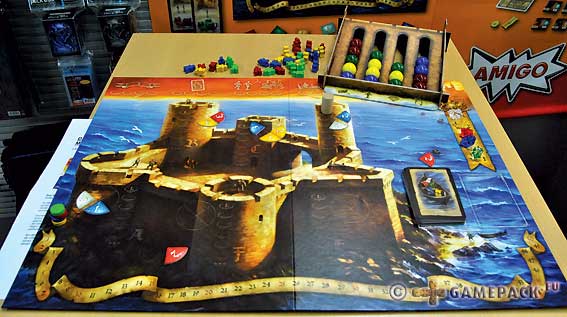 |
|
|
|
|
|
|
|
|
|
|
|
|
|
|
|
|
|
|
| x |
|
|
|
|
|
|
|
|
|
|
|
|
|
|
|
|
|
|
|
|
|
|
|
|
|
|
|
|
|
|
|
|
|
|
|
|
|
|
|
|
|
|
|
|
|
|
|
|
|
|
|
|
|
|
|
|
|
|
| The third action brings three new treasures into the game. If, after this, there are four treasures in at least one prison, scoring takes place. For each prison is determined which player has the most treasure hunters in it. This player may take as many treasures from this prison as he can take. For every treasure he needs one hunter and a bag that has a corresponding colour. The hunters and the bags then go back to the general supply. Each treasure scores as indicated on a separate market track and players advance accordingly on the scoring track. When a player has reached or exceeded 40 points, the game ends. |
|
|
|
|
|
|
|
|
|
|
|
|
|
|
|
|
|
|
| x |
|
|
|
|
|
|
|
|
|
|
|
|
|
|
|
|
|
|
|
|
|
|
|
|
|
|
|
|
|
|
|
|
|
|
|
|
|
|
|
|
|
|
|
|
|
|
|
|
|
|
|
|
|
|
|
|
|
|
| Das Geheimnis von Monte Cristo, Arnaud Urbon & Charles Chevalier, Eggertspiele, 2011 - 2 to 4 players, 10 years and up, approx. 60 minutes |
|
|
|
|
|
|
|
|
|
|
|
|
|
|
|
|
|
|
| x |
|
|
|
|
|
|
|
|
|
|
|
|
|
|
|
|
|
|
|
|
|
|
|
|
|
|
|
|
|
|
|
|
|
|
|
|
|
|
|
|
|
|
|
|
|
|
|
|
|
|
|
|
|
|
|
|
|
|
| x |
|
|
|
|
|
|
|
|
|
|
|
|
|
|
|
|
|
|
|
|
|
|
|
|
|
|
|
|
|
|
|
|
|
|
|
|
|
|
|
|
|
|
|
|
|
|
|
|
|
|
|
|
|
|
|
|
|
|
| x |
|
|
|
|
|
|
|
|
|
|
|
|
|
|
|
|
|
|
|
|
|
|
|
|
|
|
|
|
|
|
|
|
|
|
|
|
|
|
|
|
|
|
|
|
|
|
|
|
|
|
|
|
|
|
|
|
|
|
 |
Pergamon, we learn from the rules, was the most important town in the Asian Roma province of Asia - now part of Turkey - and experienced its heyday around 200 AC - the writers refuse to use the widely used and common BC. Well, write the rules in Old Asian or Sanskrite on my part but do not expect we all understand what you are trying to say or what point you want to make with it... |
|
|
|
|
|
|
|
|
|
|
|
|
|
|
|
|
|
|
| x |
|
|
|
|
|
|
|
|
|
|
|
|
|
|
|
|
|
|
|
|
|
|
|
|
|
|
|
|
|
|
|
|
|
|
|
|
|
|
|
|
|
|
|
|
|
|
|
|
|
|
|
|
|
|
|
|
|
|
Excavating the site is what players have to do; well in fact rob the place, ship the loot and bring it home and sell it to a museum. The rules only mention that the player who gets the most recognition from the museum's visitors wins the game. For the moment we'll deal with that incomplete story.
The game lasts twelve turns, each consisting of the following phases: placing new finds on the excavation site; distributing research funds; excavating, exhibiting and storing finds; evaluations.
There are 60 finds that are placed face down in a 5 high stack on the calender of the game board. Each turn one stack is turned face up, sorted by age and placed in the galleries of the excavation site.
In the research fund phase, two cards are drawn and placed face down next to the game board. The back of the card shows whether it distributes 1-4 or 5-8 money, the sum of both cards being the funds for the current turn.
After this players place their tokens on a research space of their choice. The location indicates how much funding a player wants as well as which galleries can be excavated. The cards now are revealed and the money on it is placed next to the game board. Players take money according to their position on the research funds spaces, the last player taking all the remaining funds - if he is lucky this may be more than expected and asked for. |
|
|
|
|
|
|
|
|
|
|
|
|
|
|
|
|
|
|
| x |
|
|
|
|
|
|
|
|
|
|
|
|
|
|
|
|
|
|
|
|
|
|
|
|
|
|
|
|
|
|
|
|
|
|
|
|
|
|
|
|
|
|
|
|
|
|
|
|
|
|
|
|
|
|
|
|
|
|
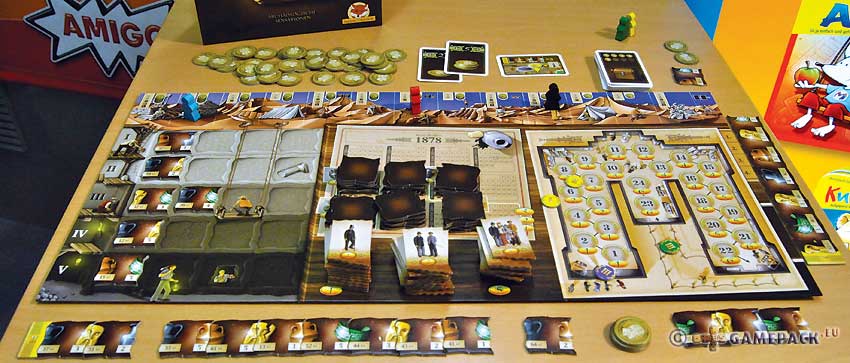 |
|
|
| x |
|
|
|
|
|
|
|
|
|
|
|
|
|
|
|
|
|
|
|
|
|
|
|
|
|
|
|
|
|
|
|
|
|
|
|
|
|
|
|
|
|
|
|
|
|
|
|
|
|
|
|
|
|
|
|
|
|
|
|
Now players excavate: a player chooses any one gallery and may excavate all finds in that gallery. Of course this costs money, the deeper the excavation the more a player pays for it. These finds need to be exhibited. One or more collections may be shown at the museum. Players assemble a collection with their finds, forming complete objects from their halves. The older the find, the more valuable the collection. As an example, a find from the 5th century AC/BC is worth 5 points, one from the 3rd century AC/BC 3 points. The value of the collection is marked at the museum with a marker in that player's colour. All collections of equal or lower value decrease in value by one when a new collection enters the museum.
|
|
|
|
|
|
|
|
|
|
|
|
|
|
|
|
|
|
|
| x |
|
|
|
|
|
|
|
|
|
|
|
|
|
|
|
|
|
|
|
|
|
|
|
|
|
|
|
|
|
|
|
|
|
|
|
|
|
|
|
|
|
|
|
|
|
|
|
|
|
|
|
|
|
|
|
|
|
|
 |
|
|
|
|
|
|
|
|
|
|
|
|
|
|
|
|
| x |
|
|
|
|
|
|
|
|
|
|
|
|
|
|
|
|
|
|
|
|
|
|
|
|
|
|
|
|
|
|
|
|
|
|
|
|
|
|
|
|
|
|
|
|
|
|
|
|
|
|
|
|
|
|
|
|
|
|
Finds that did not make it into a collection have to be stored with the first three for free and thereafter paying 1 money for each following three finds.
There are evaluations that take place in turns 5, 7, 9 and 12 were victory points are given for a players collection in the museum; these vary from 1 to 6 points as shown on the spaces in the museum. After each evaluation, all markers decrease in value, depending on the turn.
After the twelfth turn, the game ends. There is a special bonus of 3 points for the player who owns the oldest exhibit, 2 and 1 for players with less old exhibits. |
|
|
|
|
|
|
|
|
|
|
|
|
|
|
|
|
|
|
| x |
|
|
|
|
|
|
|
|
|
|
|
|
|
|
|
|
|
|
|
|
|
|
|
|
|
|
|
|
|
|
|
|
|
|
|
|
|
|
|
|
|
|
|
|
|
|
|
|
|
|
|
|
|
|
|
|
|
|
| Pergamon, Stefan Dorra & Ralf zur Linde, Eggertspiele, 2011 - 2 to 5 players, 10 years and up, approx. 45 minutes |
|
|
|
|
|
|
|
|
|
|
|
|
|
| x |
|
|
|
|
|
|
|
|
|
|
|
|
|
|
|
|
|
|
|
|
|
|
|
|
|
|
|
|
|
|
|
|
|
|
|
|
|
|
|
|
|
|
|
|
|
|
|
|
|
|
|
|
|
|
|
|
|
|
| x |
|
|
|
|
|
|
|
|
|
|
|
|
|
|
|
|
|
|
|
|
|
|
|
|
|
|
|
|
|
|
|
|
|
|
|
|
|
|
|
|
|
|
|
|
|
|
|
|
|
|
|
|
|
|
|
|
|
|
| x |
|
|
|
|
|
|
|
|
|
|
|
|
|
|
|
|
|
|
|
|
|
|
|
|
|
|
|
|
|
|
|
|
|
|
|
|
|
|
|
|
|
|
|
|
|
|
|
|
|
|
|
|
|
|
|
|
|
|
 |
Each of the two to four players owns a principality and tries to expand the city, invests in culture and military. After three game years, the player with the most victory points wins.
The game was not on display in Nürnberg (only the box on a shelf but no game components or game situation on display) which is a bit weird, as one might think this is the occasion to market a game? And, as a matter of fact, the two other games were presented only just inside, but almost outside the Amigo booth in an obscure corner. Is this really what you had in mind when you left Huch & Friends, Peter? |
|
|
|
|
|
|
|
|
|
|
|
|
|
|
|
|
|
|
| x |
|
|
|
|
|
|
|
|
|
|
|
|
|
|
|
|
|
|
|
|
|
|
|
|
|
|
|
|
|
|
|
|
|
|
|
|
|
|
|
|
|
|
|
|
|
|
|
|
|
|
|
|
|
|
|
|
|
|
Each player gets a principality that is divided into five areas: the environs, the city wall, city center, the palace and church. Players start with a hand of cards, dependent on the number of players. Each player also has a field, farm, palazzo and bank token, as well as one food, money and favor cube.
In a turn a player takes two actions; a player may choose from three: activate an action card; change an action card; take a favor cube and place it in his principality.
To activate an action card with an exchange symbol, a player must exchange the card after activation with the display. Changing an action card allows a player to exchange one of his action cards for a card of the display. At the end of a players turn, he removes the leftmost action card from the display. The other cards are moved to the left and the display is refilled. |
|
|
|
|
|
|
|
|
|
|
|
|
|
|
|
|
|
|
| x |
|
|
|
|
|
|
|
|
|
|
|
|
|
|
|
|
|
|
|
|
|
|
|
|
|
|
|
|
|
|
|
|
|
|
|
|
|
|
|
|
|
|
|
|
|
|
|
|
|
|
|
|
|
|
|
|
|
|
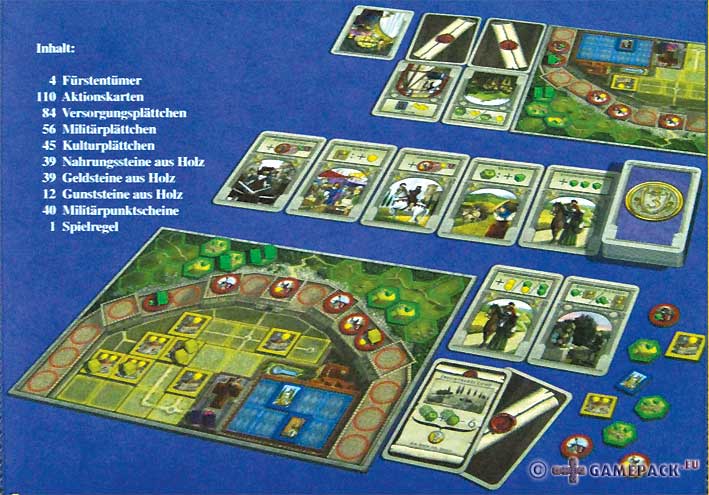 |
|
|
|
|
| x |
|
|
|
|
|
|
|
|
|
|
|
|
|
|
|
|
|
|
|
|
|
|
|
|
|
|
|
|
|
|
|
|
|
|
|
|
|
|
|
|
|
|
|
|
|
|
|
|
|
|
|
|
|
|
|
|
|
|
| There is a military scoring round at the end of a year; players are allowed to move food to military tokens, and money to condottiere tokens. Each catapult scores 1, each condottiere scores 1 if supplied with a food cube, and the like. Military strength between players is compared and victory points awarded according to a victory chart. There are two additional military scoring rounds which are triggered when a military scoring card is revealed from the refill pile. |
|
|
|
|
|
|
|
|
|
|
|
|
|
|
|
|
|
|
| x |
|
|
|
|
|
|
|
|
|
|
|
|
|
|
|
|
|
|
|
|
|
|
|
|
|
|
|
|
|
|
|
|
|
|
|
|
|
|
|
|
|
|
|
|
|
|
|
|
|
|
|
|
|
|
|
|
|
|
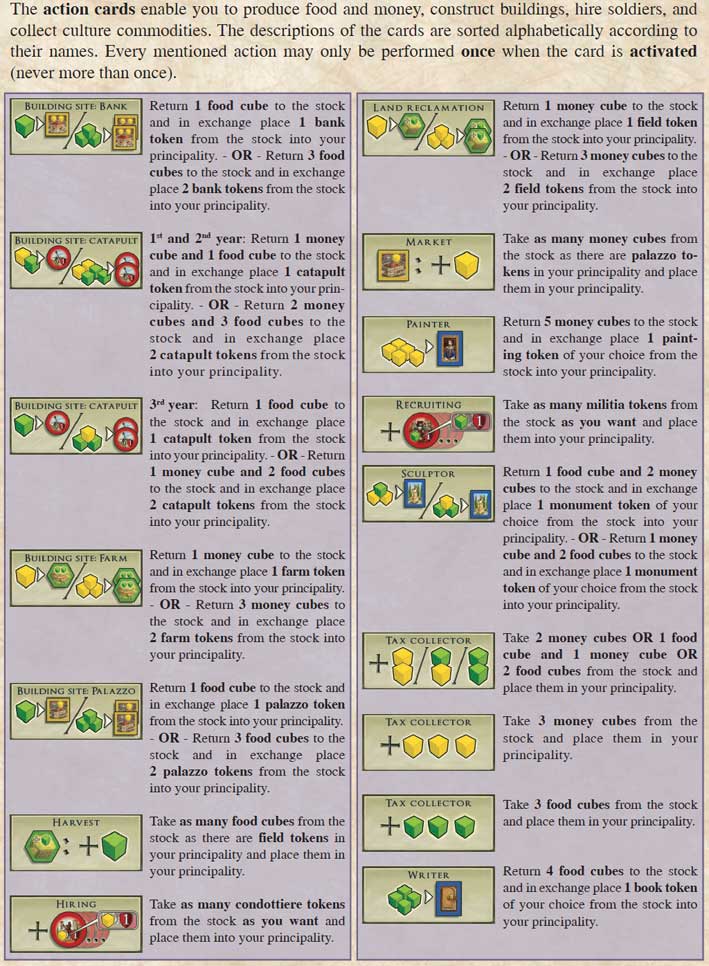 |
|
|
|
|
| x |
|
|
|
|
|
|
|
|
|
|
|
|
|
|
|
|
|
|
|
|
|
|
|
|
|
|
|
|
|
|
|
|
|
|
|
|
|
|
|
|
|
|
|
|
|
|
|
|
|
|
|
|
|
|
|
|
|
|
| When the third year is over and after the annual military scoring round, players add their victory points according to the military victory bills they received during the game; the value on each culture token they collected during the game; and the degree to which they managed to complete their goal cards. The player with the most victory points, well, he just wins the game, but doesn't he always? |
|
|
|
|
|
|
|
|
|
|
|
|
|
|
|
|
|
|
| x |
|
|
|
|
|
|
|
|
|
|
|
|
|
|
|
|
|
|
|
|
|
|
|
|
|
|
|
|
|
|
|
|
|
|
|
|
|
|
|
|
|
|
|
|
|
|
|
|
|
|
|
|
|
|
|
|
|
|
| Principato, Touko Tahkokallio, Eggertspiele, 2011 - 2 to 4 players, 12 years and up, 45-90 minutes |
|
|
|
|
|
|
|
|
|
|
|
|
|
|
|
|
| x |
|
|
|
|
|
|
|
|
|
|
|
|
|
|
|
|
|
|
|
|
|
|
|
|
|
|
|
|
|
|
|
|
|
|
|
|
|
|
|
|
|
|
|
|
|
|
|
|
|
|
|
|
|
|
|
|
|
|
| x |
|
|
|
|
|
|
|
|
|
|
|
|
|
|
|
|
|
|
|
|
|
|
|
|
|
|
|
|
|
|
|
|
|
|
|
|
|
|
|
|
|
|
|
|
|
|
|
|
|
|
|
|
|
|
|
 |
|
|
|
|
|
|
|
|
|
|
|
|
|
|
|
|
|
|
|
|
|
|
|
|
|
|
|
|
|
|
|
|
|
|
|
|
|
|
|
|
|
|
|
|
|
|
|
|
|
|
|
|
|
|
|
|
|
 |
|
|
|
|
|
|
|
|
|
|
|
|
|
|
|
|
|
|
|
|
|
|
|
|
|
|
|
|
|
|
|
|
|
|
|
|
|
|
|
|
|
|
|
|
|
|
|
|
|
|
|
|
|
|
|
|
 |
|
|
|
|
|
|
|
|
|
|
|
|
|
|
|
|
|
|
|
|
|
|
|
|
|
|
|
|
|
|
|
|
|
|
|
|
|
|
|
|
|
|
|
|
|
|
|
|
|
|
|
|
|
|
|
|
|
 |
|
|
|
|
|
|
|
|
|
|
|
|
|
|
|
|
|
|
|
|
|
|
|
|
|
|
|
|
|
|
|
|
|
|
|
|
|
|
|
|
|
|
|
|
|
|
|
|
|
|
|
|
|
|
|
|
|
 |
|
|
|
|
|
|
|
|
|
|
|
|
|
|
|
|
|
|
|
|
|
|
|
|
|
|
|
|
|
|
|
|
|
|
|
|
|
|
|
|
|
|
|
|
|
|
|
|
|
|
|
|
|
|
|
| x |
|
|
|
|
|
|
|
|
|
|
|
|
|
|
|
|
|
|
|
|
|
|
|
|
|
|
|
|
|
|
|
|
|
|
|
|
|
|
|
|
|
|
|
|
|
|
|
|
|
|
|
|
|
|
|
|
|
|
 |
|
|
|
|
|
|
|
|
|
|
|
|
|
|
|
|
|
|
|
|
|
|
|
|
|
|
|
|
|
|
|
|
|
|
|
|
|
|
|
|
|
|
|
|
|
|
|
|
|
|
|
|
|
|
|
|
|
|
|
|
|
|
|
|
|
|
|
|
|
|
|
|
|
|
|
|
|
|
|
|
|
|
|
|
|
|
|
|
|
|
|
|
|
|
|
|
|
|
|
|
|